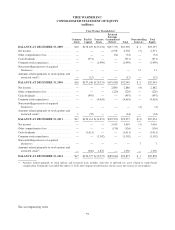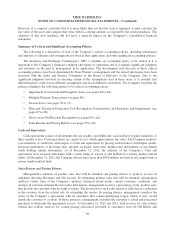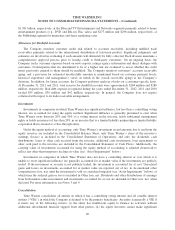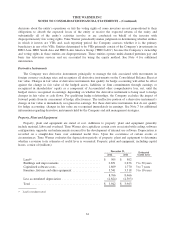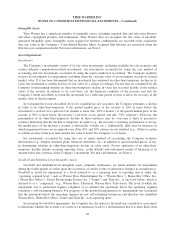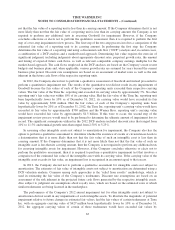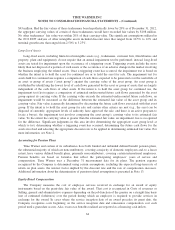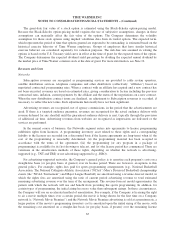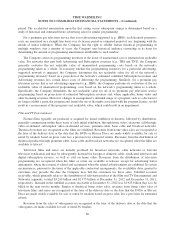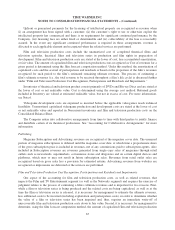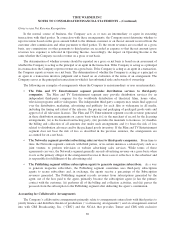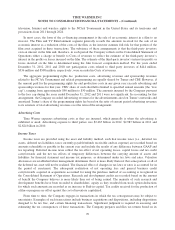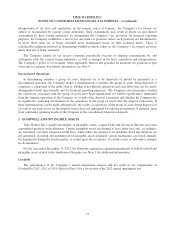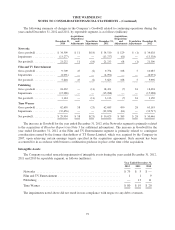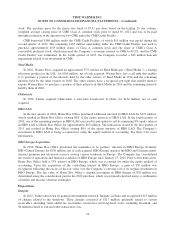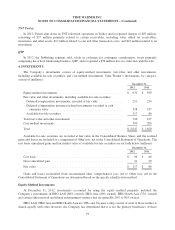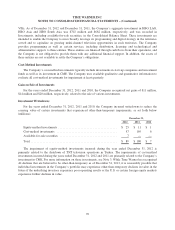Time Magazine 2012 Annual Report Download - page 83
Download and view the complete annual report
Please find page 83 of the 2012 Time Magazine annual report below. You can navigate through the pages in the report by either clicking on the pages listed below, or by using the keyword search tool below to find specific information within the annual report.TIME WARNER INC.
NOTES TO CONSOLIDATED FINANCIAL STATEMENTS – (Continued)
Upfront or guaranteed payments for the licensing of intellectual property are recognized as revenue when
(i) an arrangement has been signed with a customer, (ii) the customer’s right to use or otherwise exploit the
intellectual property has commenced and there is no requirement for significant continued performance by the
Company, (iii) licensing fees are either fixed or determinable and (iv) collectability of the fees is reasonably
assured. In the event any significant continued performance is required in these arrangements, revenue is
allocated to each applicable element and recognized when the related services are performed.
Film and television production costs include the unamortized cost of completed theatrical films and
television episodes, theatrical films and television series in production and film rights in preparation of
development. Film and television production costs are stated at the lower of cost, less accumulated amortization,
or fair value. The amount of capitalized film and television production costs recognized as Cost of revenues for a
given period is determined using the film forecast computation method. Under this method, the amortization of
capitalized costs and the accrual of participations and residuals is based on the proportion of the film’s revenues
recognized for such period to the film’s estimated remaining ultimate revenues. The process of estimating a
film’s ultimate revenues (i.e., the total revenue to be received throughout a film’s life cycle) is discussed further
under “Film and Television Production Cost Recognition, Participations and Residuals and Impairments.”
Inventories of theatrical and television product consist primarily of DVDs and Blu-ray Discs and are stated at
the lower of cost or net realizable value. Cost is determined using the average cost method. Returned goods
included in Inventory are valued at estimated realizable value, but not in excess of cost. For more information,
see Note 6.
Videogame development costs are expensed as incurred before the applicable videogames reach technical
feasibility. Unamortized capitalized videogame production and development costs are stated at the lower of cost
or net realizable value and reported in Noncurrent inventories and film and television production costs on the
Consolidated Balance Sheet.
The Company enters into collaborative arrangements from time to time with third parties to jointly finance
and distribute certain of its theatrical productions. See “Accounting for Collaborative Arrangements” for more
information.
Publishing
Magazine Subscription and Advertising revenues are recognized at the magazine cover date. The unearned
portion of magazine subscriptions is deferred until the magazine cover date, at which time a proportionate share
of the gross subscription price is included in revenues, net of any commissions paid to subscription agents. Also
included in Subscription revenues are revenues generated from single-copy sales of magazines through retail
outlets such as newsstands, supermarkets, convenience stores and drugstores and on certain digital devices and
platforms, which may or may not result in future subscription sales. Revenues from retail outlet sales are
recognized based on gross sales less a provision for estimated returns. Advertising revenues from websites are
recognized as impressions are delivered or the services are performed.
Film and Television Production Cost Recognition, Participations and Residuals and Impairments
One aspect of the accounting for film and television production costs, as well as related revenues, that
impacts the Film and TV Entertainment segment (as well as the Networks segment) and requires the exercise of
judgment relates to the process of estimating a film’s ultimate revenues and is important for two reasons. First,
while a film or television series is being produced and the related costs are being capitalized, as well as at the
time the film or television series is released, it is necessary for management to estimate the ultimate revenues,
less additional costs to be incurred (including exploitation and participation costs), in order to determine whether
the value of a film or television series has been impaired and, thus, requires an immediate write-off of
unrecoverable film and television production costs down to fair value. Second, it is necessary for management to
determine, using the film forecast computation method, the amount of capitalized film and television production
67


